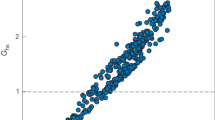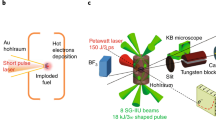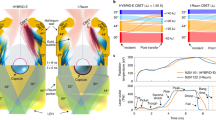Abstract
Recent experiments in the study of inertial confinement fusion (ICF) at the National Ignition Facility (NIF) in the United States have reached the so-called alpha-heating regime1,2,3, in which the self-heating by fusion products becomes dominant, with neutron yields now exceeding 1 × 1016 (ref. 4) However, there are still challenges on the path towards ignition, such as minimization of the drive asymmetry, suppression of laser-plasma instabilities, and mitigation of fabrication features5. In addition, in the current cylindrical-hohlraum indirect drive schemes for ICF, a strong limitation is the inefficient (≤10%) absorption of the laser-produced hohlraum X-rays by the capsule as set by relative capsule-to-hohlraum surface areas. Here we report an experiment demonstrating ~30% energy coupling to an aluminium capsule in a rugby-shaped6, gold hohlraum. This high coupling efficiency can substantially increase the tolerance to residual imperfections and improve the prospects for ignition, both in mainline single-shell hot-spot designs and potential double-shell targets.
This is a preview of subscription content, access via your institution
Access options
Access Nature and 54 other Nature Portfolio journals
Get Nature+, our best-value online-access subscription
$29.99 / 30 days
cancel any time
Subscribe to this journal
Receive 12 print issues and online access
$209.00 per year
only $17.42 per issue
Buy this article
- Purchase on Springer Link
- Instant access to full article PDF
Prices may be subject to local taxes which are calculated during checkout





Similar content being viewed by others
Data availability
The data that support the findings of this study are available from the corresponding author upon reasonable request.
References
Hurricane, O. A. et al. Fuel gain exceeding unity in an inertially confined fusion implosion. Nature 506, 343–348 (2014).
Hurricane, O. A. et al. Inertially confined fusion plasmas dominated by alpha-particle self-heating. Nat. Phys. 12, 800–806 (2016).
Doeppner, T. et al. Demonstration of high performance in layered deuterium–tritium capsule implosions in uranium hohlraums at the National Ignition Facility. Phys. Rev. Lett. 115, 055001 (2015).
Le Pape, S. et al. Fusion energy output greater than the kinetic energy of an imploding shell at the National Ignition Facility. Phys. Rev. Lett. 120, 245003 (2018).
Betti, R. & Hurricane, O. A. Inertial-confinement fusion with lasers. Nat. Phys. 12, 435–448 (2016).
Amendt, P. A. et al. Rugby-like hohlraum experimental designs for demonstrating X-ray drive enhancement. Phys. Plasmas 15, 012702 (2008).
Nuckolls, J., Wood, L., Thiessen, A. & Zimmerman, G. Laser compression of matter to super-high densities: thermonuclear (CTR) applications. Nature 239, 139–142 (1972).
Herrmann, M. C., Tabak, M. & Lindl, J. Ignition scaling laws and their application to capsule design. Phys. Plasmas 8, 2296–2304 (2001).
Atzeni, S. & Meyer-ter-vehn, J. The Physics of Inertial Fusion (Oxford Univ. Press, New York, 2004).
Lindl, J. et al. Review of the National Ignition Campaign 2009–2012. Phys. Plasmas 21, 020501 (2014).
Amendt, P. A. et al. Assessing the prospects for achieving double-shell ignition on the National Ignition Facility using vacuum hohlraums. Phys. Plasmas 14, 056312 (2007).
Kline, J. L. et al. Developing one-dimensional implosions for inertial confinement science. High Power Laser Sci. Eng. 4, 44–50 (2016).
Amendt, P. A. et al. Hohlraum-driven ignitionlike double-shell implosions on the OMEGA laser facility. Phys. Rev. Lett. 94, 065004 (2005).
Robey, H. F. et al. Hohlraum-driven mid-Z (SiO2) double-shell implosions on the OMEGA laser facility and their scaling to NIF. Phys. Rev. Lett. 103, 145003 (2009).
Varnum, W. S. et al. Progress toward ignition with noncryogenic double-shell capsules. Phys. Rev. Lett. 84, 5153–5155 (2000).
Kyrala, G. A. et al. Detailed diagnosis of a double-shell collision under realistic implosion conditions. Phys. Plasmas 13, 056306 (2006).
Callahan, D. A. et al. Exploring the limits of case-to-capsule ratio, pulse length, and picket energy for symmetric hohlraum drive on the National Ignition Facility laser. Phys. Plasmas 25, 056305 (2018).
Miller, G. H., Moses, E. I. & Wuest, C. R. The National Ignition Facility. Opt. Eng. 43, 2841–2853 (2004).
Lindl, J. Development of the indirect-drive approach to inertial confinement fusion and the target physics basis for ignition and gain. Phys. Plasmas 2, 3933–4024 (1995).
Dewald, E. L. et al. Dante soft X-ray power diagnostic for National Ignition Facility. Rev. Sci. Instru. 75, 3759–3761 (2004).
Hicks, D. G. et al. Streaked radiography measurements of convergent ablator performance. Rev. Sci. Instrum. 81, 10E304 (2010).
Opachich, Y. P. et al. X-ray streak camera cathode development and timing accuracy of the 4ω ultraviolet fiducial system at the National Ignition Facility. Rev. Sci. Instrum. 83, 10E123 (2012).
Tommasini, R. et al. Tent-induced perturbations on areal density of implosions at the National Ignition Facility. Phys. Plasmas 22, 056315 (2015).
Rygg, J. R. et al. 2D X-ray radiography of imploding capsules at the National Ignition Facility. Phys. Rev. Lett. 112, 195001 (2014).
Glenn, S. M. et al. Extracting core shape from X-ray images at the National Ignition Facility. Rev. Sci. Instrum. 83, 10E519 (2012).
Barrios, M. A. et al. X-ray area backlighter development at the National Ignition Facility. Rev. Sci. Instrum. 85, 11D502 (2014).
Zimmerman, G. B. & Kruer, W. L. Numerical simulation of laser-initiated fusion. Comments Plasma Phys. Controlled Fusion 2, 51–60 (1975).
Scott, H. A. & Hansen, S. B. Advances in NLTE modeling for integrated simulations. High Energy Density Phys. 6, 39–47 (2010).
Jones, O. S. et al. Progress towards a more predictive model for hohlraum radiation drive and symmetry. Phys. Plasmas 24, 056312 (2017).
Moody, J. et al. Progress in hohlraum physics for the National Ignition Facility. Phys. Plasmas 21, 056317 (2014).
Amendt, P., Milovich, J., Perkins, L.J. & Robey, H. An indirect-drive non-cryogenic double-shell path to 1ω Nd-laser hybrid inertial fusion–fission energy. Nucl. Fusion 50, 105006 (2010).
Acknowledgements
We thank the NIF team at LLNL for excellent laser operation and technical support. We also would like to thank the target fabrication group for outstanding work on development and delivery of the high-quality Al capsules. This work was performed under the auspices of the US DOE by LLNL under contract number DEAC52-07NA27344. Y.P. acknowledges support from the DOE/ECRP Program. Y.M.W. acknowledges LLNL LDRD (17-ERD-048) support.
Author information
Authors and Affiliations
Contributions
Y.P. and V.A.S. carried out the experimental set-up and execution with help from R.T., E.D., A.G.M. and J.E.R.. P.A. was the target designer and performed the pre- and post-shot simulations. R.T., J.F., S.K., Y.P., V.A.S. and O.L.L. contributed to the data analysis. D.B., S.J., A.N., R.S. and Y.M.W. contributed to fabrication of the high-quality Al capsules, D.S. contributed to backscatter mitigation, F.G., J.P., S.P. and R.E.T. contributed to the planning and simulations. E.L., E.M. and D.M. contributed to the backlighter and radiography development. Y.P. wrote the manuscript and P.A. wrote the simulation and full design sections. Y.P., V.A.S., P.A., R.T., O.L.L., A.G.M. and Y.M.W. contributed to the manuscript improvements.
Corresponding author
Ethics declarations
Competing interests
The authors declare no competing interests.
Additional information
Publisher’s note: Springer Nature remains neutral with regard to jurisdictional claims in published maps and institutional affiliations.
Supplementary information
Supplementary Information
1 chapter, 3 figures, 0 references, 0 tables
Rights and permissions
About this article
Cite this article
Ping, Y., Smalyuk, V.A., Amendt, P. et al. Enhanced energy coupling for indirectly driven inertial confinement fusion. Nature Phys 15, 138–141 (2019). https://doi.org/10.1038/s41567-018-0331-5
Received:
Accepted:
Published:
Issue Date:
DOI: https://doi.org/10.1038/s41567-018-0331-5
This article is cited by
-
Probing atomic physics at ultrahigh pressure using laser-driven implosions
Nature Communications (2022)
-
Mitigation of laser plasma parametric instabilities with broadband lasers
Reviews of Modern Plasma Physics (2022)
-
Specific heat ratio effects of compressible Rayleigh—Taylor instability studied by discrete Boltzmann method
Frontiers of Physics (2021)
-
Interspecies radiative transition in warm and superdense plasma mixtures
Nature Communications (2020)



